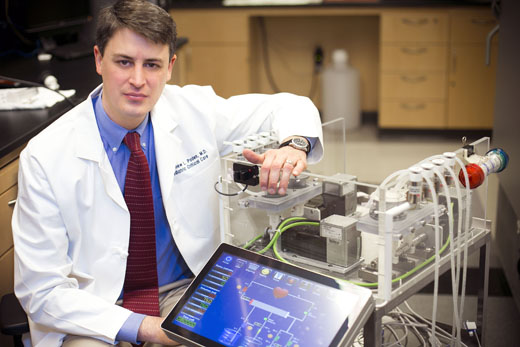According to a new report by the Extracorporeal Life Support Organization (ELSO), ECLS continues to increase in the pediatric respiratory, adult respiratory, and cardiac ECLS populations, and its use has stabilized in the neonatal respiratory population.
The upward trend is expected to continue, driven largely by the increasing use of adult respiratory ECLS. ELSO centers and ECLS played an important role in clinical response to the 2009 H1N1 influenza pandemic, supporting 317 respiratory patients worldwide with 65 percent overall survival.
Results of summary data from the annual ELSO Registry Reports through July 2012 are published in the ASAIO Journal. Matthew Paden, MD, assistant professor of pediatrics (critical care) at Emory University School of Medicine and Children’s Healthcare of Atlanta, was first author of the report, along with co-authors at Louisiana State University Health Sciences Center, Children’s Hospital Boston and Harvard Medical School, on behalf of the ELSO Registry.
ELSO is an international consortium of health care professionals and scientists dedicated to the development and evaluation of novel therapies for support of failing organ systems. Its primary mission is to maintain a registry of ECLS use in active ELSO centers. Registry data is used to support clinical research, regulatory agencies, and individual ELSO centers.
"As a comprehensive database, the ELSO Registry is a valuable resource for the ECLS community, clinicians, industry, and regulatory agencies, and it continues to undergo changes and additions in response to changing populations and numbers of treated patients," notes Paden. "A new web-based data entry system in 2013 will make it much easier for clinicians and should improve response rates and accuracy."
Nearly 51,000 patients have received ECLS, including 25,000 neonates with respiratory failure who had a 75 percent survival rate to discharge or transfer. Congenital diaphragmatic hernia also was a major use for ECLS, with a 51 percent survival rate.
ECLS for pediatric respiratory failure (children older than one month) has nearly doubled since 2000, including approximately 350 patients treated each year over the past three years, resulting in a 56 percent survival.
Adult respiratory failure ECLS cases increased dramatically in 2009 with the H1N1 influenza pandemic and remained at approximately 400 cases a year through 2011, with 55 percent survival. ECLS use continues to grow in cardiac support, with approximately 13,000 patients treated with survival to discharge rates of 40 percent, 49 percent, and 39 percent for neonates, pediatric and adult cardiac patients respectively.
Other system improvements in 2013 will include a new real-time query capability, allowing members easy access to the latest data, and the addition of six commonly used severity of illness scoring systems for neonatal, pediatric and adult patients to aid in future analysis of patients treated at different centers or time periods. Restructuring of the registry will improve categorization of patients for greater specificity.
A limited version of Registry summary data also will be provided to the public on the ELSO community web site. Linking ELSO Registry data to other large patient databases could allow better evaluation of outcomes, better patient selection for procedures, improved timing, and patient management.
The upward trend is expected to continue, driven largely by the increasing use of adult respiratory ECLS. ELSO centers and ECLS played an important role in clinical response to the 2009 H1N1 influenza pandemic, supporting 317 respiratory patients worldwide with 65 percent overall survival.
Results of summary data from the annual ELSO Registry Reports through July 2012 are published in the ASAIO Journal. Matthew Paden, MD, assistant professor of pediatrics (critical care) at Emory University School of Medicine and Children’s Healthcare of Atlanta, was first author of the report, along with co-authors at Louisiana State University Health Sciences Center, Children’s Hospital Boston and Harvard Medical School, on behalf of the ELSO Registry.
ELSO is an international consortium of health care professionals and scientists dedicated to the development and evaluation of novel therapies for support of failing organ systems. Its primary mission is to maintain a registry of ECLS use in active ELSO centers. Registry data is used to support clinical research, regulatory agencies, and individual ELSO centers.
"As a comprehensive database, the ELSO Registry is a valuable resource for the ECLS community, clinicians, industry, and regulatory agencies, and it continues to undergo changes and additions in response to changing populations and numbers of treated patients," notes Paden. "A new web-based data entry system in 2013 will make it much easier for clinicians and should improve response rates and accuracy."
Nearly 51,000 patients have received ECLS, including 25,000 neonates with respiratory failure who had a 75 percent survival rate to discharge or transfer. Congenital diaphragmatic hernia also was a major use for ECLS, with a 51 percent survival rate.
ECLS for pediatric respiratory failure (children older than one month) has nearly doubled since 2000, including approximately 350 patients treated each year over the past three years, resulting in a 56 percent survival.
Adult respiratory failure ECLS cases increased dramatically in 2009 with the H1N1 influenza pandemic and remained at approximately 400 cases a year through 2011, with 55 percent survival. ECLS use continues to grow in cardiac support, with approximately 13,000 patients treated with survival to discharge rates of 40 percent, 49 percent, and 39 percent for neonates, pediatric and adult cardiac patients respectively.
Other system improvements in 2013 will include a new real-time query capability, allowing members easy access to the latest data, and the addition of six commonly used severity of illness scoring systems for neonatal, pediatric and adult patients to aid in future analysis of patients treated at different centers or time periods. Restructuring of the registry will improve categorization of patients for greater specificity.
A limited version of Registry summary data also will be provided to the public on the ELSO community web site. Linking ELSO Registry data to other large patient databases could allow better evaluation of outcomes, better patient selection for procedures, improved timing, and patient management.

